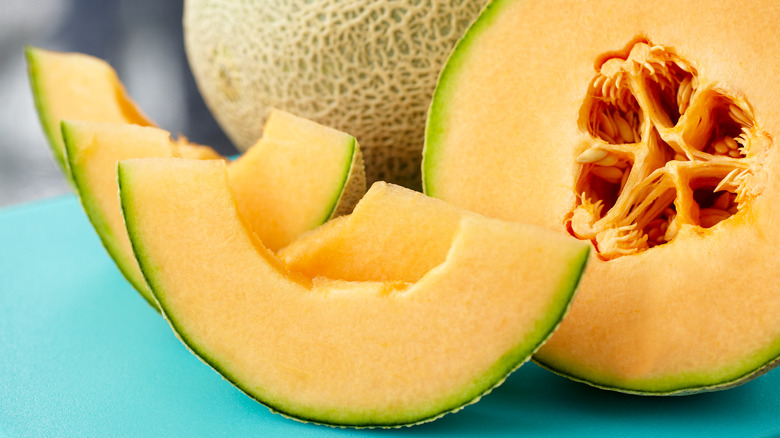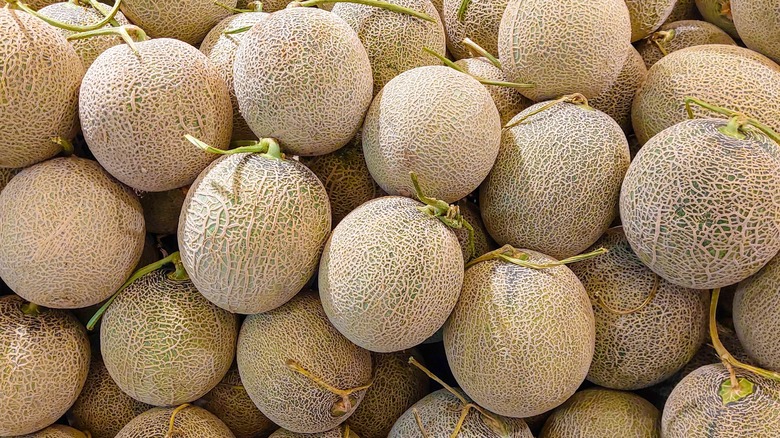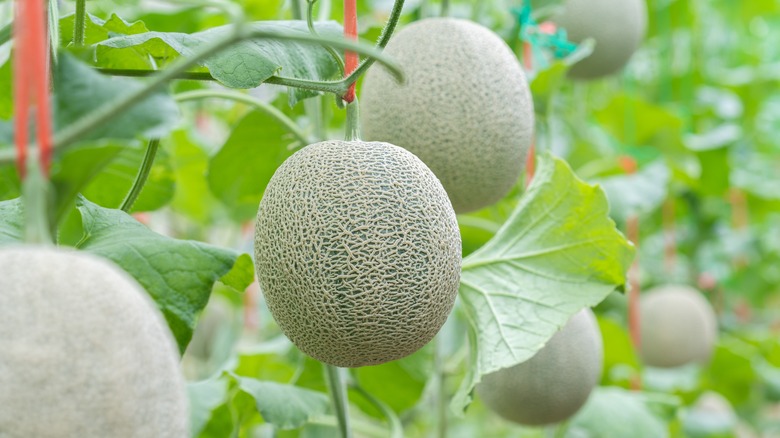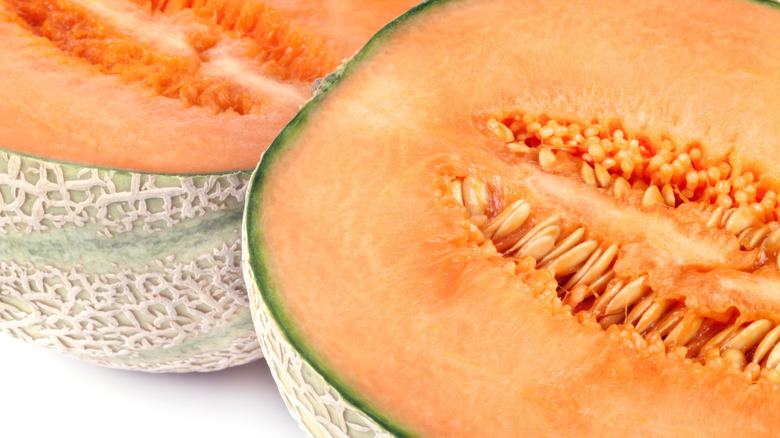What You Need To Know To Choose The Tastiest Cantaloupe At The Store
Shopping for fresh fruit and other produce at your local grocery store seems easy because it's all in one place, and you can sort through to find the perfect piece. But what if you don't know what to look for? Different fruits and veggies have different telltale signs to separate the good from the bad. With cantaloupe, which has a thick skin that prevents you from seeing its interior, it's not always so easy to tell. If you don't want the pre-cut fruit, there are a few tips and tests you can do right in the produce section to make sure you're taking home the best cantaloupe possible.
Cantaloupe is a type of melon; it's related to others, like watermelon or honeydew, but it isn't quite as melt-in-your-mouth as watermelon and has a sweeter taste than honeydew. Cantaloupes are at their best during June through August, so that's step one to finding the best fruit. Beyond that, you'll want to examine it for things like color, firmness, and scent.
For the best cantaloupe, buy it in season
Most fruits and vegetables don't grow all year round, so buying them while they're in season means you get the best quality flavor and color. Most of the United States' cantaloupe comes from five states: California, Arizona, Georgia, Indiana, and Colorado. California is the United States' greatest cantaloupe producer, growing nearly 700,000 tons of the fruit each year.
If you take a closer look at your fruits and veggies, you'll almost always see a label on the individual fruit (or on the package) that shows where it was produced. So, for the sweetest flavor and brightest color, check for a locally grown label during the summer months. Grown in the U.S. often means the fruit spent less time in shipping too. Off-season, cantaloupes likely come from a high-producing country in South America, like Guatemala, and while they'll still be available, they're susceptible to longer shipping times and higher prices. Plus, they can be harder to find.
Do a visual check of your cantaloupe's exterior
At first, every cantaloupe in the store will look about the same, but there are some key details you should keep an eye out for. Cantaloupes that come from the Americas have a skin that almost resembles a web. It's usually a light green color with cream-colored "netting" throughout. (In the U.S., you'll likely buy an American cantaloupe; European cantaloupes have a slightly different appearance and are less common here.) Look for thick netting, and feel the fruit for firmness. It shouldn't be soft, but it also shouldn't be rock hard. The perfect cantaloupe has a small amount of give but is less firm than its watermelon relative.
The cantaloupe's stem is also a giveaway. Make sure there isn't a stem — cantaloupes shouldn't be picked until their stems come off with ease, so no stem means it was picked at the proper time. Press down on where the stem used to be, and see if the cantaloupe feels a little softer. This is a good sign that it's ripe. If you can hardly press down at all, it needs more time.
Finally, check for scent and sound
If you're fine with getting a few funny looks while shopping in the produce aisle, there are two more tips for determining freshness. First, pick up those cantaloupes and give them a good whiff. You know that signature melon smell — sweet enough but with a hint of fragrant, funky musk (definitely not too funky though). If you smell the cantaloupe and its signature scent is shining through, then that's a good sign. You can smell a few to compare, then choose the best one that way.
Another telltale test that might receive a few glances: shake, shake, shake. Don't get too wild here, but just give the cantaloupe a light shake to see if you hear any seeds rumbling around. The seeds should remain attached to a cantaloupe for as long as it's fresh, so if you hear any jostling, that's a sign the seeds have fallen, meaning the cantaloupe is no longer fresh.
So, from the get-go, pay attention to what time of year you're buying cantaloupe and where it's coming from. Then, on the outside, look for proper color, firmness, and smell. And on the inside, listen to make sure there are no tumbling seeds.



